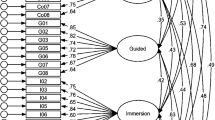Abstract
The importance of affect in delivering engaging experiences in entertainment and educational games is well recognized. Yet, current techniques for building affect-aware games are limited, with the maintenance and use of affect in essence being handcrafted for each game. The Koko architecture describes a service-oriented middleware that reduces the burden of incorporating affect recognition into games, thereby enabling developers to concentrate on the functional and creative aspects of their applications. The Koko architecture makes three key contributions: (1) improving developer productivity by creating a reusable and extensible environment; (2) yielding an enhanced user experience by enabling independently developed games and other applications to collaborate and provide a more coherent user experience than currently possible; (3) enabling affective communication in multiplayer and social games. Further, Koko is intended to be used as an extension of existing game architectures. We recognize that complex games require additional third party libraries, such as game engines. To enable the required flexibility we define the interfaces of the Koko architecture in a formal manner, thereby enabling the implementation of those interfaces to readily adapt to the unique requirements of game’s other architectural components and requirements.
Similar content being viewed by others
References
Ashri, R., Luck, M., & d’Inverno, M. (2002). Infrastructure support for agent-based development. In Foundations and applications of multi-agent Systems, volume 2403 of LNCS (pp. 1542–1558). Berlin: Springer.
Bickmore, T., Mauer, D., Crespo, F., & Brown, T. (2007). Persuasion, task interruption and health regimen adherence. In Second International Conference on Persuasive Technology for Human Well-Being (Persuasive), April 2007, Stanford, CA.
Bioware Group a division of Electronic Arts Inc. Mass Effect (2010). http://bioware.com.
Conat, C., & Maclaren, H. (2005). Data-driven refinement of a probabilistic model of user affect. In User modeling 2005, volume 3538 of LNCS (pp. 40–49), August 2005. Berlin: Springer.
Conati, C., & Maclaren, H. (2009) Modeling user affect from causes and effects. In Proceedings of the 17th International Conference on User Modeling, Adaptation, and Personalization, volume 5535 of LNCS (pp. 4–15), September 2009. Berlin: Springer.
Continua (2009). Continua health alliance. http://www.continuaalliance.org.
Dias, J., & Paiva, A. (2005). Feeling and reasoning: A computational model for emotional characters. In Progress in artificial intelligence, volume 3808 of LNCS (pp. 127–140). Berlin: Springer.
Elliott, C. (1992). The affective reasoner: A process model of emotions in a multi-agent system. PhD Thesis, Northwestern University, Evanston, IL.
Elliott C., Rickel J., Lester J. (1999) Lifelike pedagogical agents and affective computing: An exploratory synthesis. Artificial Intelligence Today, LNAI 1600: 195–212
Epic Games Inc. (2009). Unreal engine. http://www.epicgames.com.
Filman R. E., Barrett S., Lee D. D., Linden T. (2002) Inserting ilities by controlling communications. Communications of the ACM 45(1): 116–122
Gilroy, S., Cavazza, M., Niiranen, M., André, E., Vogt, T., Urbain, J., Benayoun, M., Seichter, H., & Billinghurst, M. (2009). PAD-based multimodal affective fusion. Proceedings of the Third International Conference on Affective Computing and Intelligent Interaction (pp. 1–8). Amsterdam: IEEE.
Goleman D. (2006) Social intelligence: The new science of human relationships. Bantam Books, New York, NY
Gratch J., Marsella S. (2003) Fight the way you train: The role and limits of emotions in training for combat. The Brown Journal of World Affairs X(1): 63–76
Gratch J., Marsella S. (2004) A domain-independent framework for modeling emotion. Journal of Cognitive Systems Research 5(4): 269–306
Gratch J., Mao W., Marsella S. (2006) Modeling social emotions and social attributions. Cambridge University Press, Cambridge, UK
Gratch, J., Marsella, S., Wang, N., & Stankovic, B. (2009). Assessing the validity of appraisal-based models of emotion. Proceedings of Third International Conference on Affective Computing and Intelligent Interaction (pp. 1–8). Amsterdam: IEEE.
Lazarus R. S. (1991) Emotion and adaptation. Oxford University Press, New York, NY
Lee S., McQuiggan S.W., & Lester, J. C. (2007). Proceedings of the Eleventh International Conference on User Modeling, volume 4511 of LNCS, inducing user affect recognition models for task-oriented environments (pp. 380–384). Berlin: Springer.
Lim, M. Y., Dias, J., Aylett, R., & Paiva, A. (2009). Intelligent npcs for education role play game. In F. Dignum, B. Silverman, J. Bradshaw, & W. van Doesburg (Eds.), Proceedings of the First International Workshop on Agents for Games and Simulations, volume 5920 of LNAI (pp. 107–118). Berlin: Springer.
Marsella, S., Johnson, W. L., & LaBore, C. (2000). Interactive pedagogical drama. In Proceeding of Fourth International Conference on Autonomous Agents (pp. 301–308). Montreal, QC, Canada.
Marsella, S., Gratch, J., Wang, N., & Stankovic, B. (2009). Assessing the validity of a computational model of emotional coping. Proceedings of the Third International Conference on Affective Computing and Intelligent Interaction (pp. 1–8). Amsterdam: IEEE.
Martinho, C., Machado, I., & Paiva, A. (2000). A cognitive approach to affective user modeling. In Affective interactions, volume 1814 of LNAI (pp. 64–75). Berlin: Springer.
McQuiggan, S., Lee, S., & Lester, J. (2006). Predicting user physiological response for interactive environments: An inductive approach. In J. E. Laird & J. Schaeffer (Eds.), Proceedings of the Second Artificial Intelligence and Interactive Digital Entertainment Conference (pp. 60–65). Stanford, CA: AAAI Press.
Newell A. (1990) Unified theories of cognition. Harvard University Press, Cambridge, MA
OpenSocial Foundation (2009). Opensocial. http://www.opensocial.org.
Ortony A., Clore G. L., Collins A. (1988) The cognitive structure of emotions. Cambridge University Press, Cambridge, MA
Picard R. W. (1997) Affective computing. MIT Press, Cambridge, MA
Picard R. W., Healey J. (1997) Affective wearables. Personal and Ubiquitous Computing 1(4): 231–240
Reynolds, C., & Picard, R.W. (2004). Affective sensors, privacy, and ethical contracts. In Proceedings of the 22nd International Conference on Human Factors in Computing Systems (pp. 1103–1106). New York: ACM.
Rollings A., Morris D. (2000) Game architecture and design. Coriolis, Scottsdale, AZ
Shaw M., Garlan D. (1996) Software architecture: Perspectives on an emerging discipline. Prentice-Hall, Upper Saddle River, NJ
Silverman, B., Chandrasekaran, D., Weyer, N., Pietrocola, D., Might, R., & Weaver, R. (2009). Nonkin village: A training game for learning cultural terrain and sustainable counter-insurgent operations. In F. Dignum, B. Silverman, J. Bradshaw, & W. van Doesburg (Eds.), Proceedings of the First International Workshop on Agents for Games and Simulations, volume 5920 of LNAI (pp. 135–154). Berlin: Springer.
Smith C., Lazarus R. (1990) Emotion and adaptation. In: Pervin L. A., John O. P. (eds) Handbook of personality: Theory and research. Guilford Press, New York, NY, pp 609–637
Sollenberger, D. J., & Singh, M. P. (2009). Architecture for affective social games. In F. Dignum, B. Silverman, J. Bradshaw, & W. van Doesburg (Eds.), Proceedings of the First International Workshop on Agents for Games and Simulations, volume 5920 of LNAI (pp. 135–154). Berlin: Springer.
Sollenberger, D. J., & Singh, M. P. (2011). Methodology for engineering affective social applications. In M. P. Gleizes, & J. J. Gomez-Sanz (Eds.), Proceedings of the Tenth International Workshop on Agent-Oriented Software Engineering, volume 6038 of LNCS (pp. 97–109). Berlin: Springer.
Spivey J. M. (1992) The Z notation: A reference manual. Prentice Hall, London, UK
Ubisoft Entertainment Inc. (2010). Assassin’s Creed. http://www.ubi.com.
Valve Software Inc. (2009). Source engine. http://source.valvesoftware.com.
Wagner J., André E., Jung F. (2009). Smart sensor integration: A framework for multimodal emotion recognition in real-time. Proceedings of the Third International Conference on Affective Computing and Intelligent Interaction. Amsterdam: IEEE.
Witten I. H., Frank E. (2005) Data mining: Practical machine learning tools and techniques (2nd ed.). Morgan Kaufmann, San Francisco, CA
Author information
Authors and Affiliations
Corresponding author
Additional information
This is a revised and extended version of an article that appears as [35].
Rights and permissions
About this article
Cite this article
Sollenberger, D.J., Singh, M.P. Koko: an architecture for affect-aware games. Auton Agent Multi-Agent Syst 24, 255–286 (2012). https://doi.org/10.1007/s10458-010-9160-3
Published:
Issue Date:
DOI: https://doi.org/10.1007/s10458-010-9160-3




